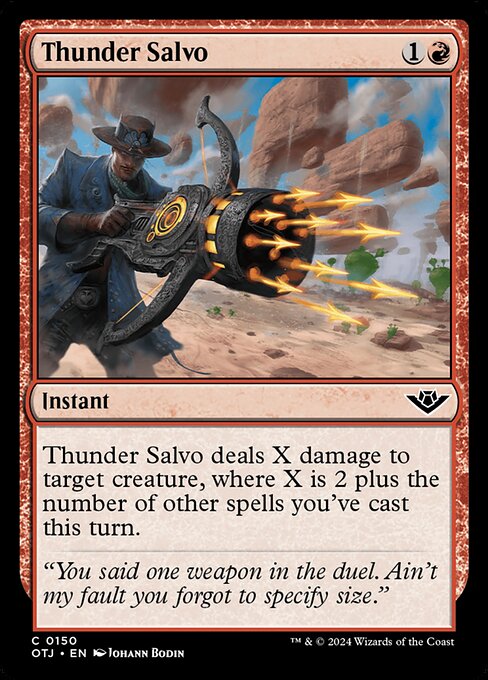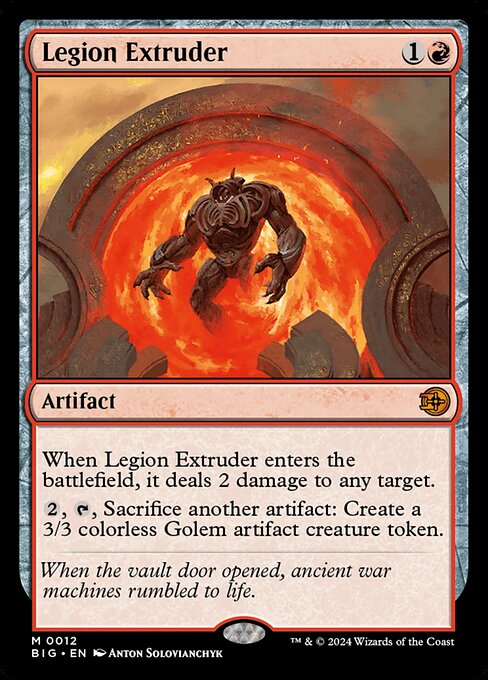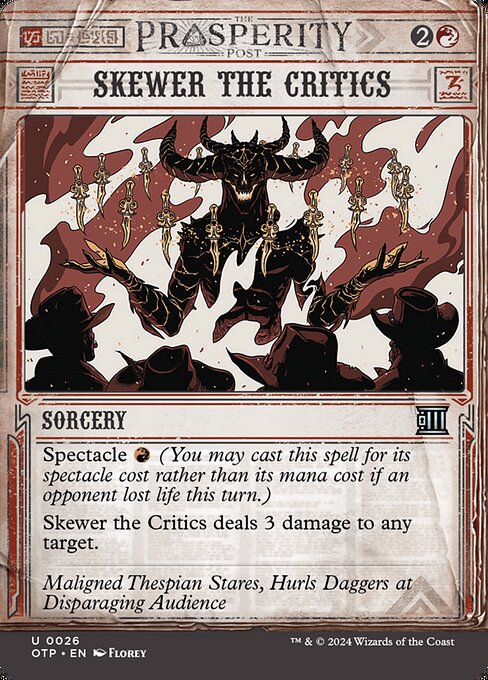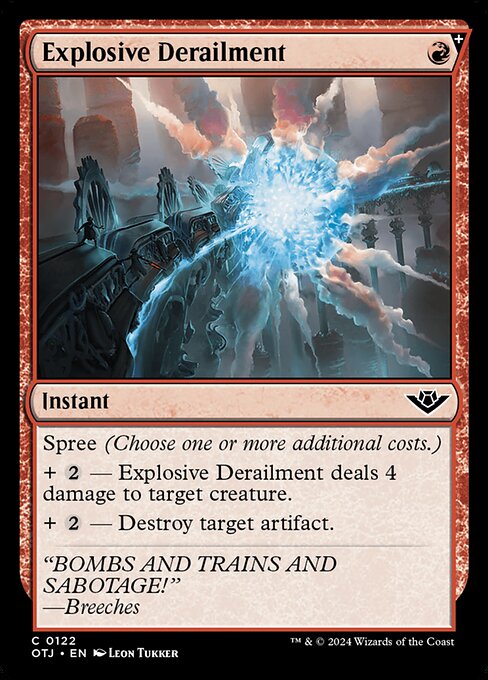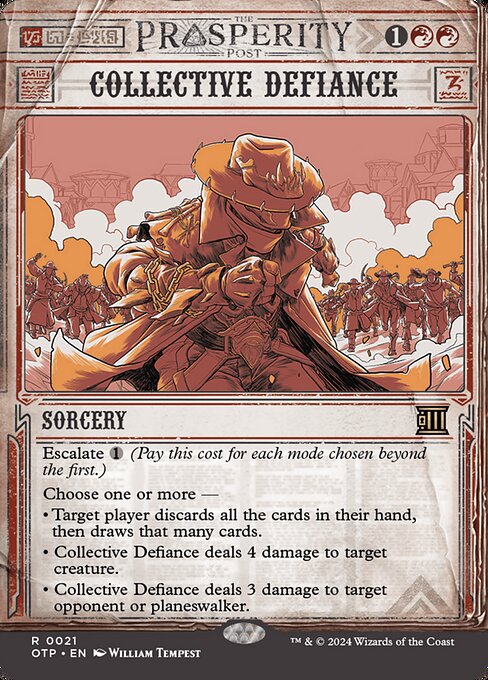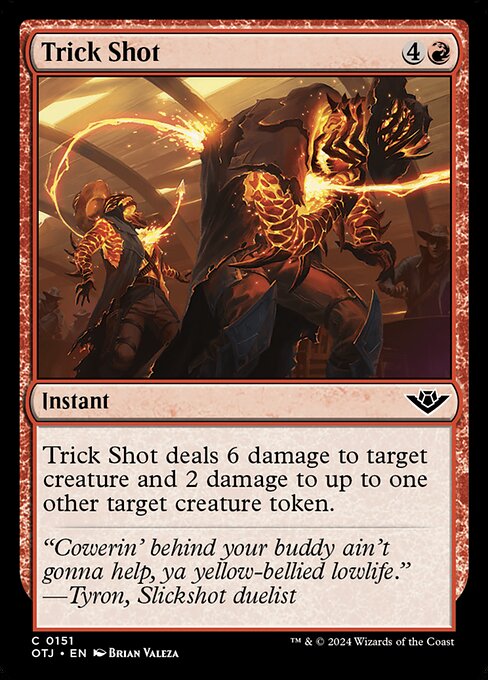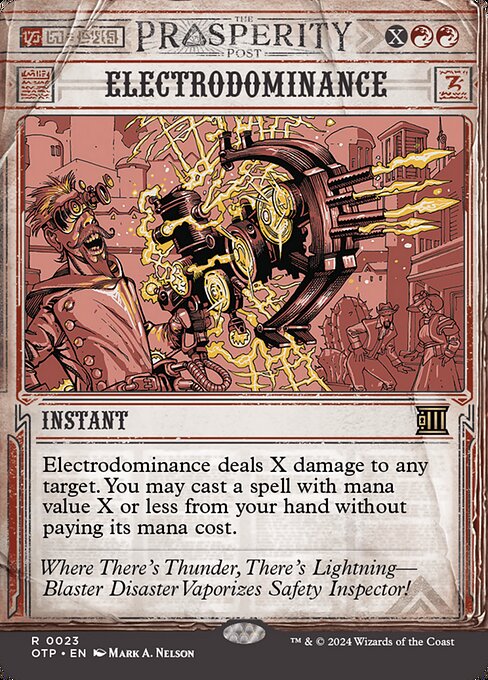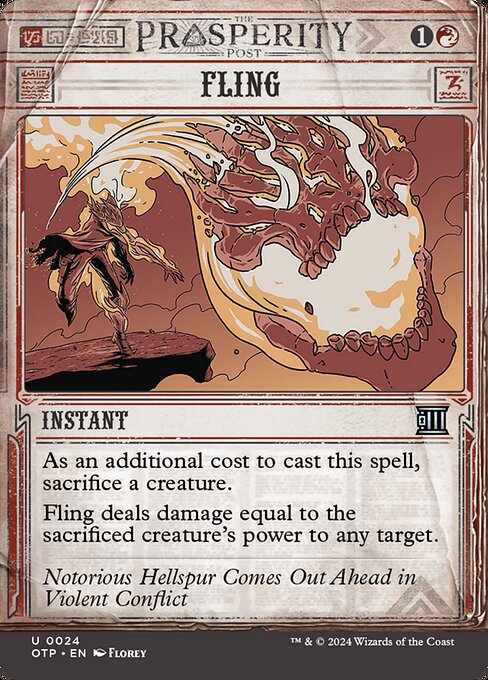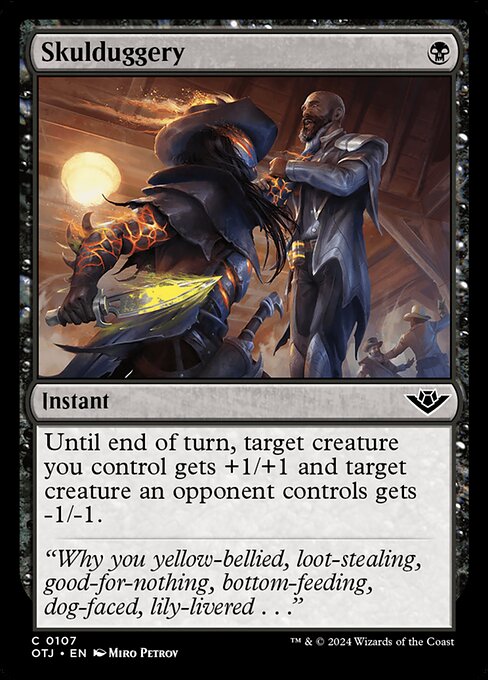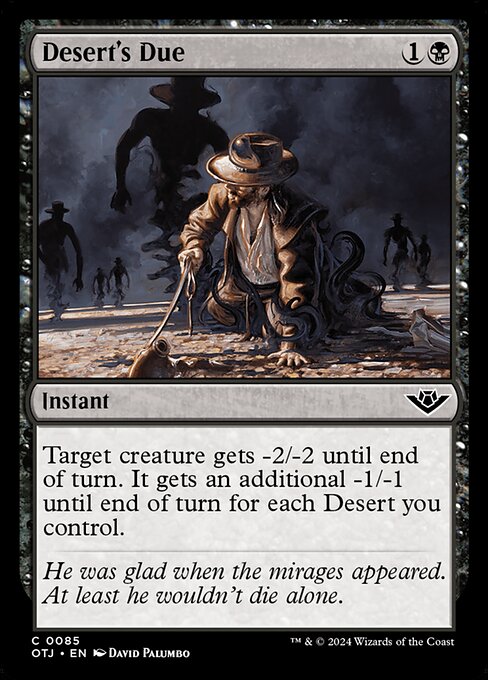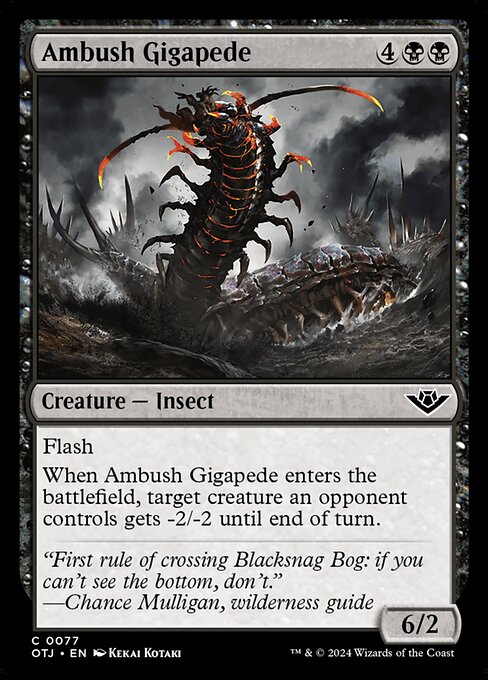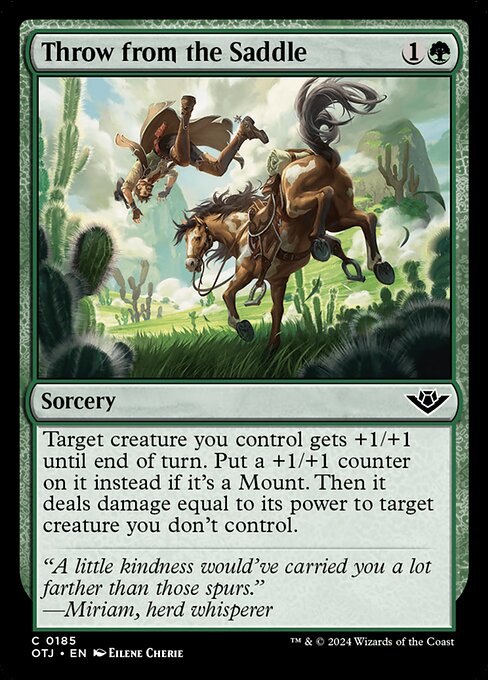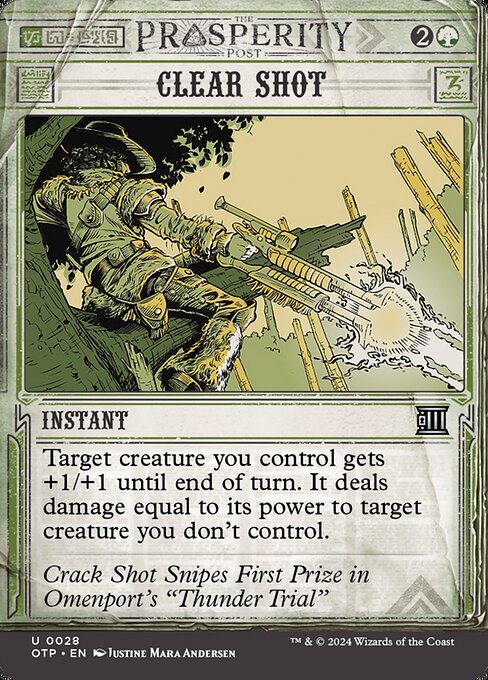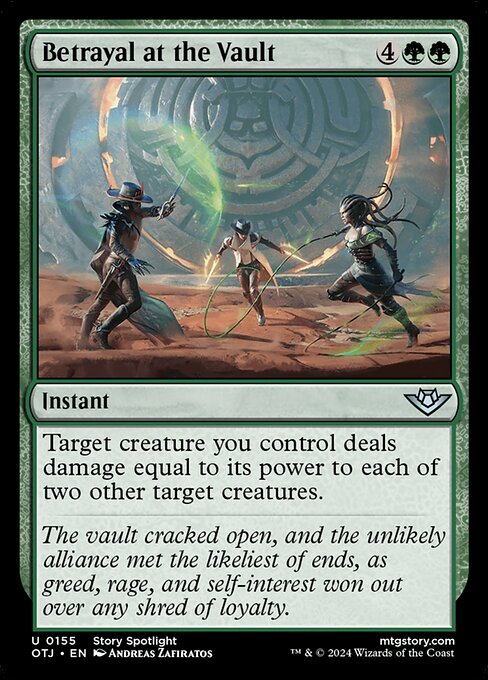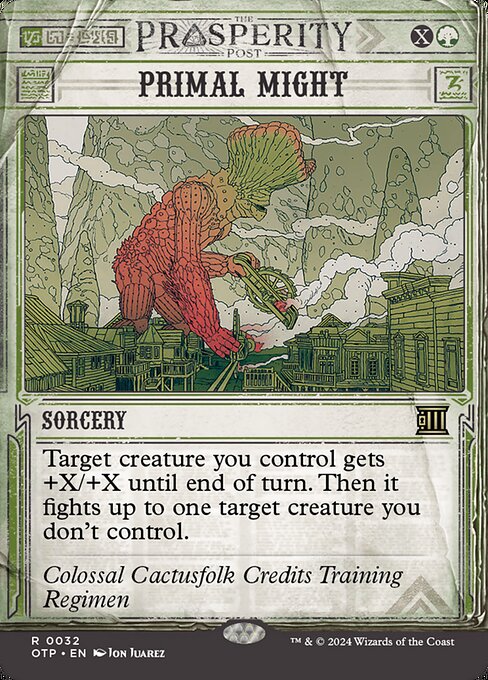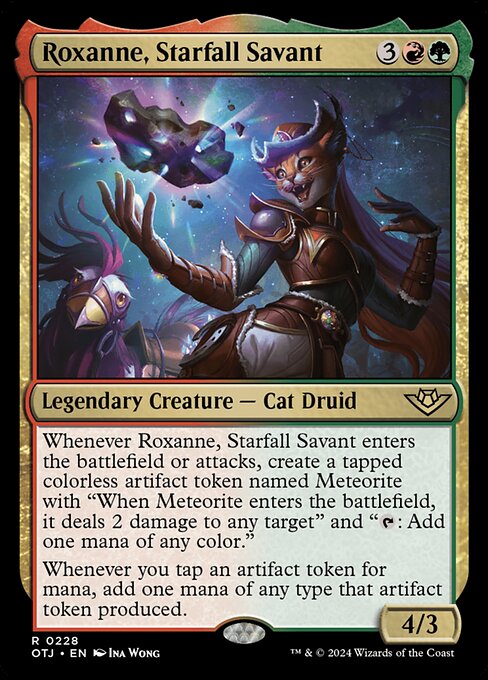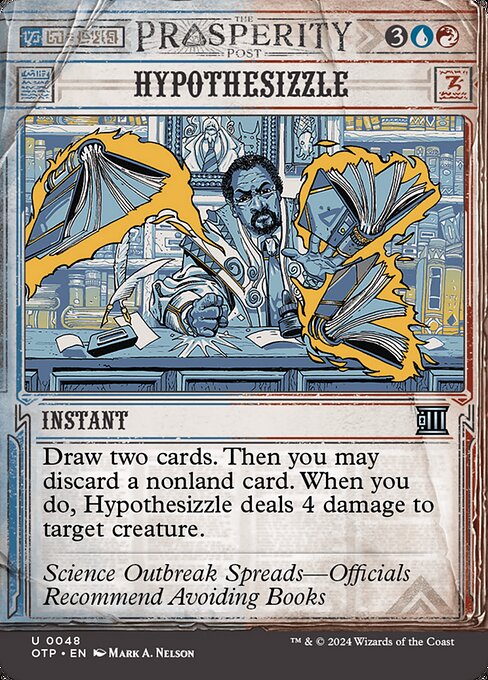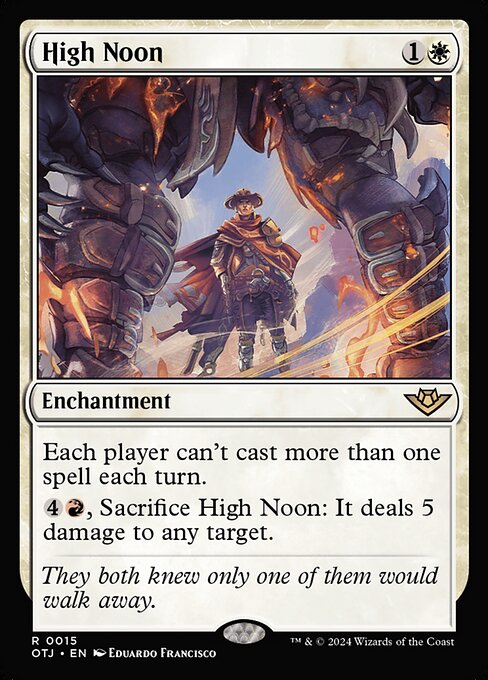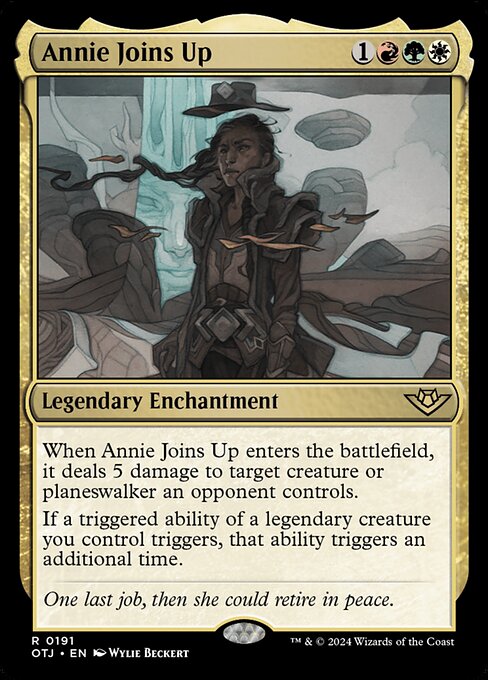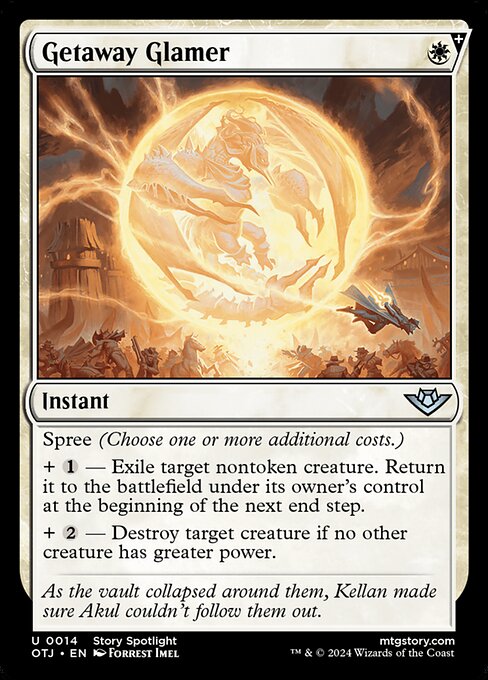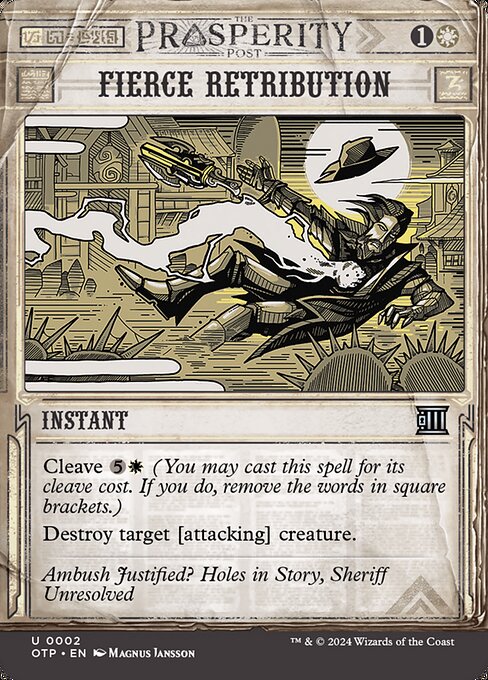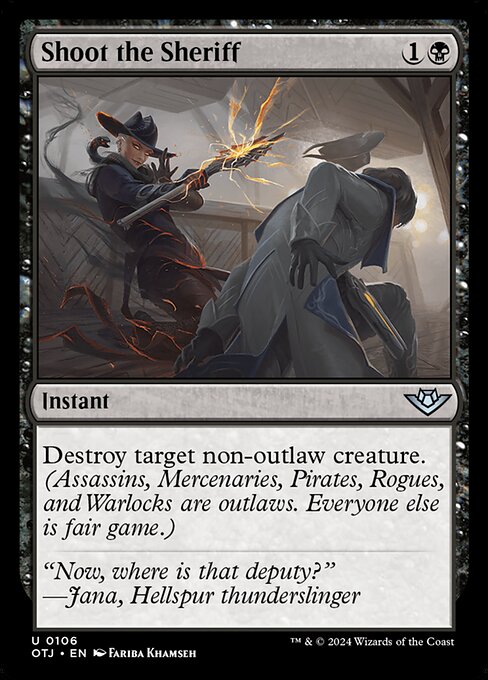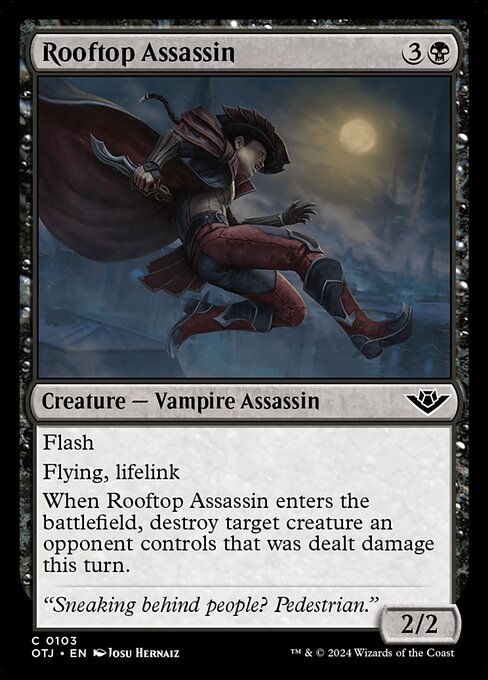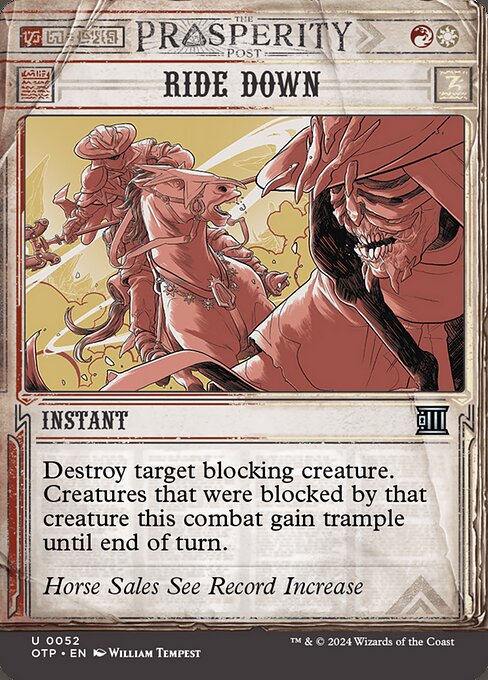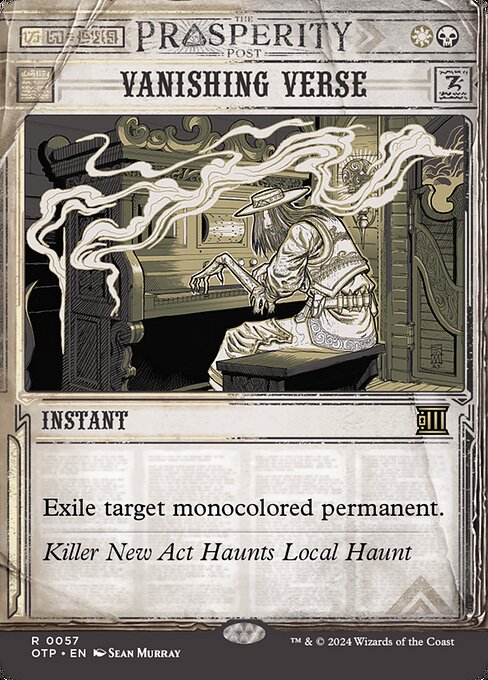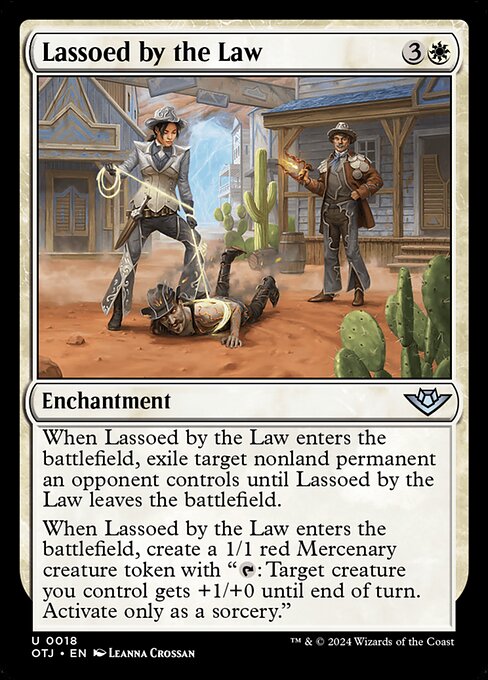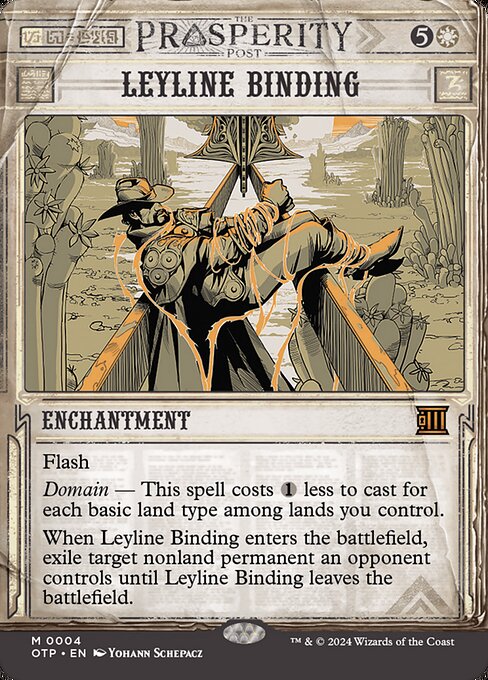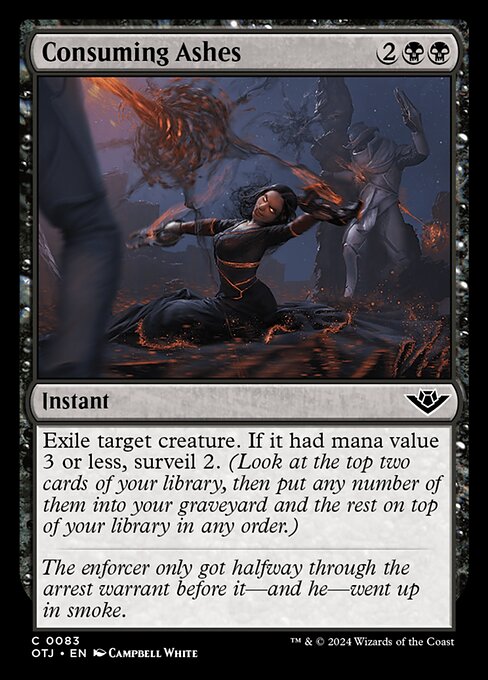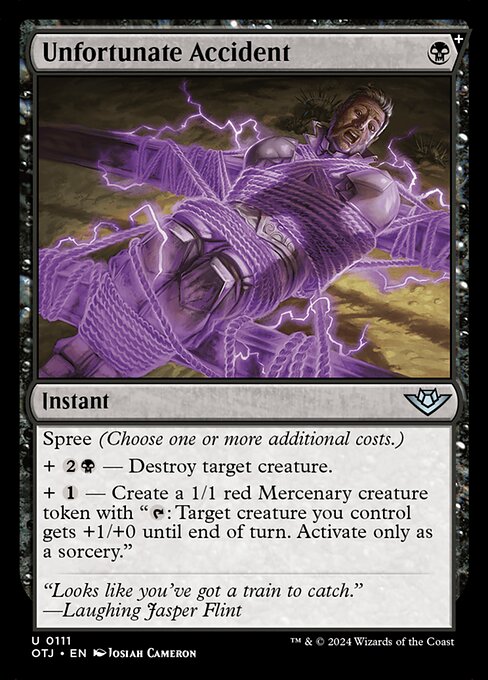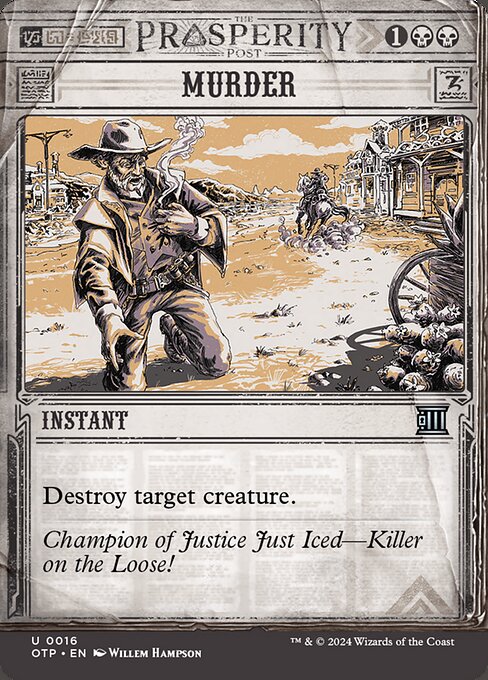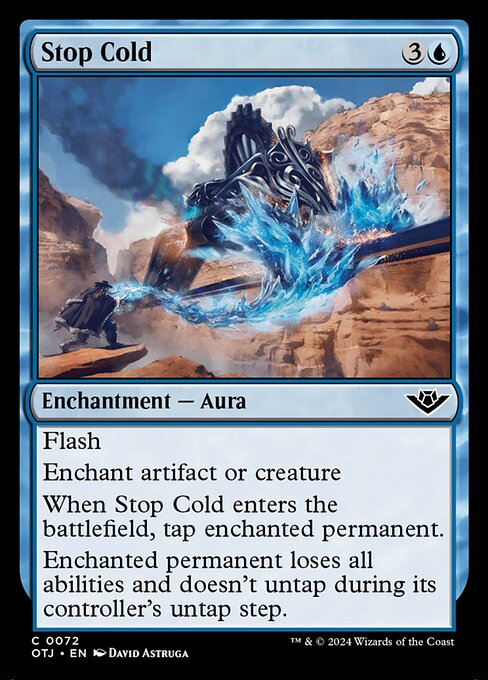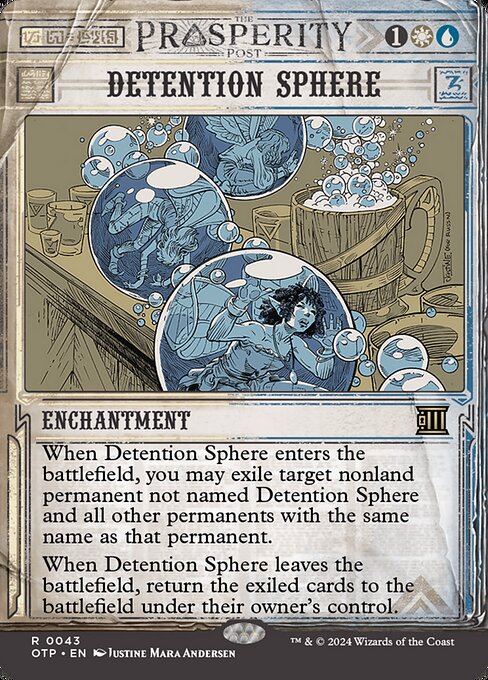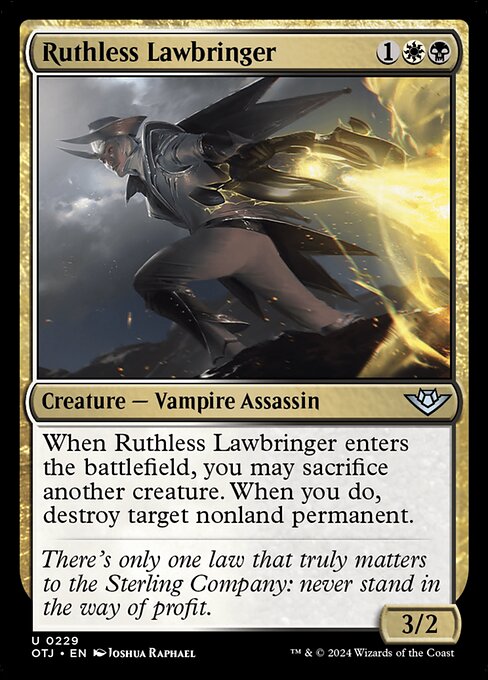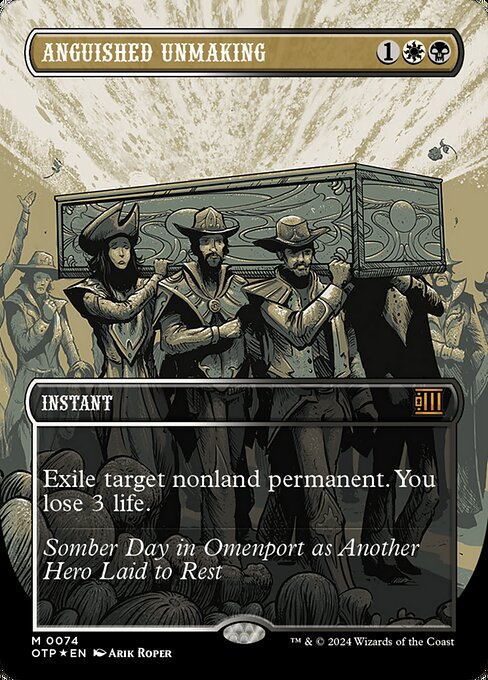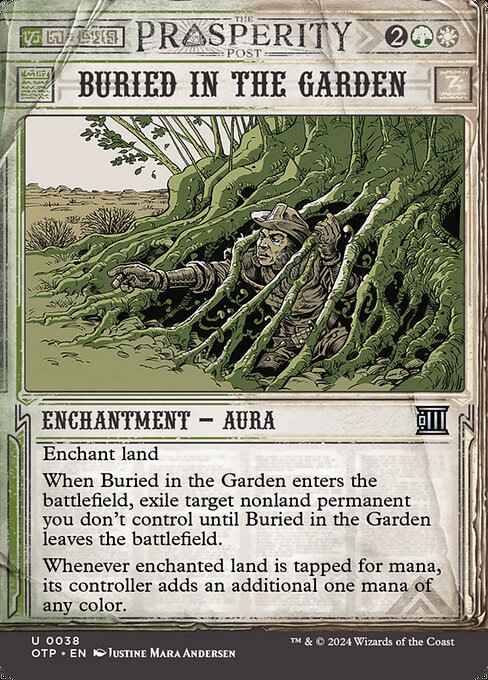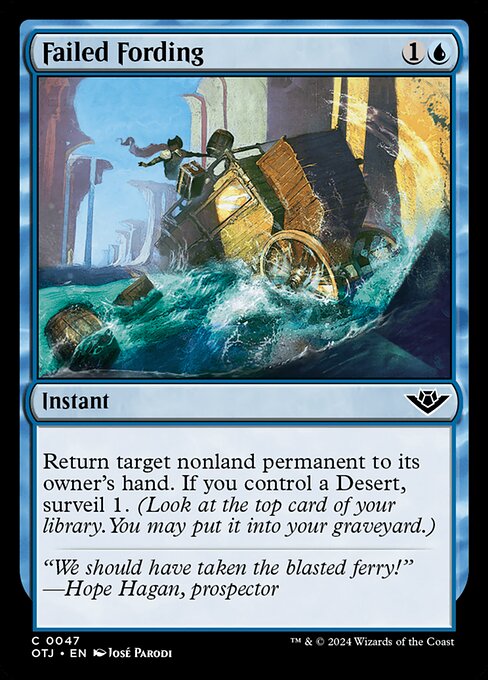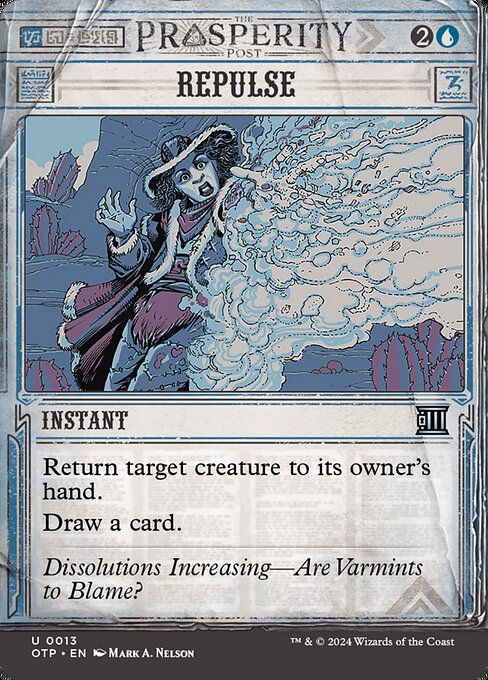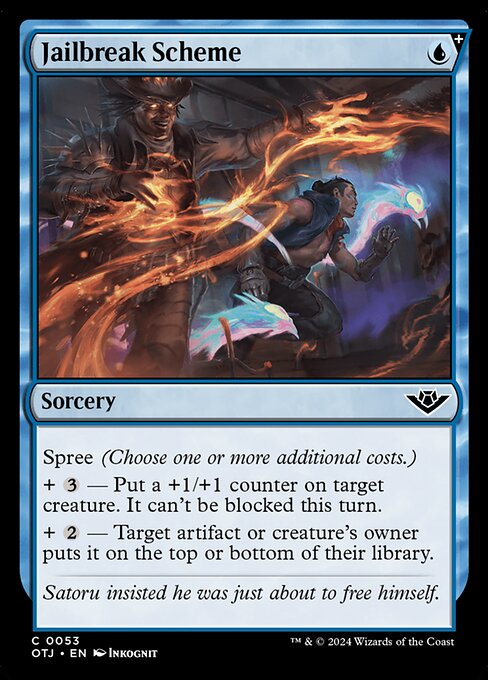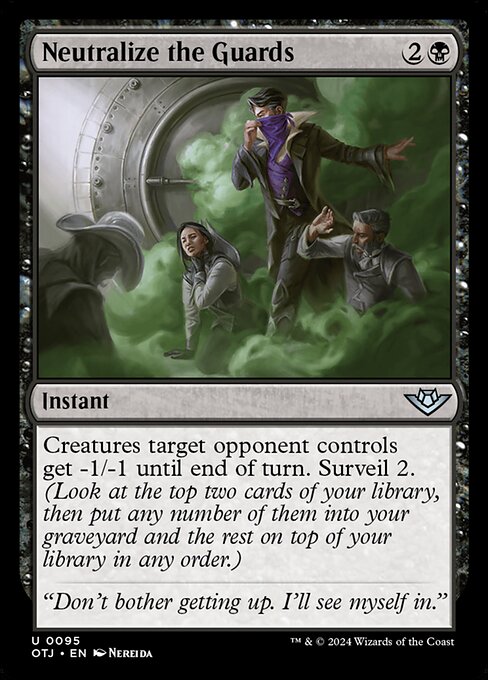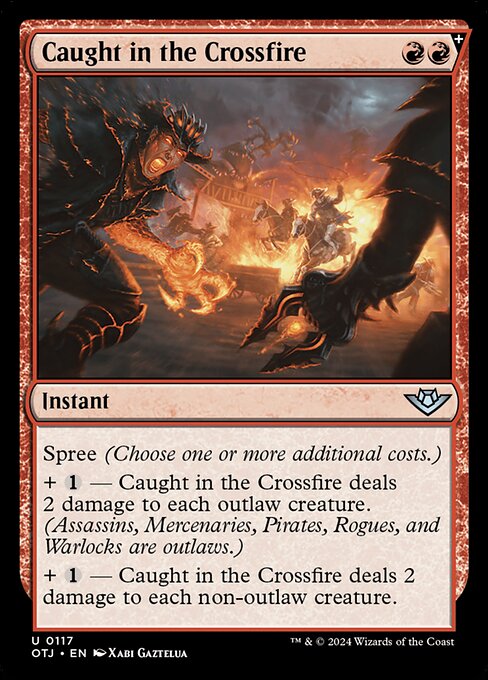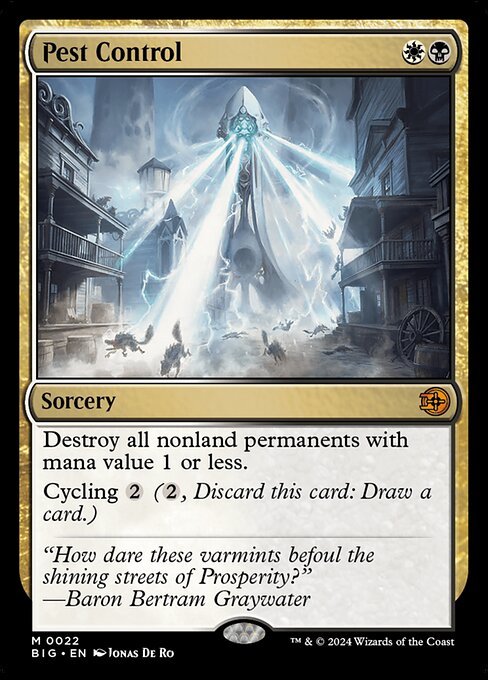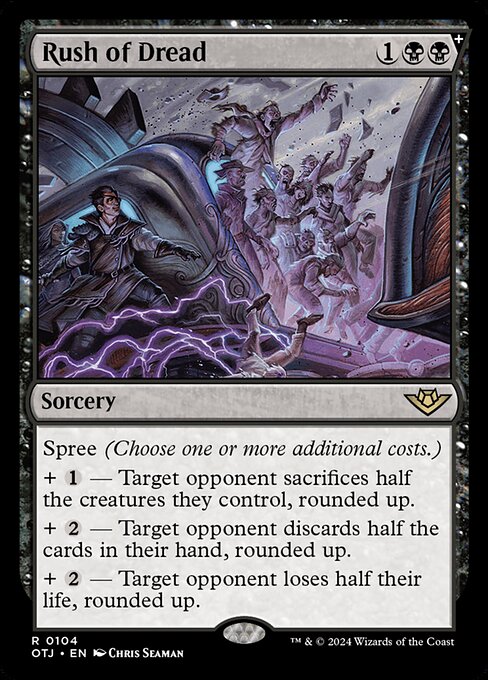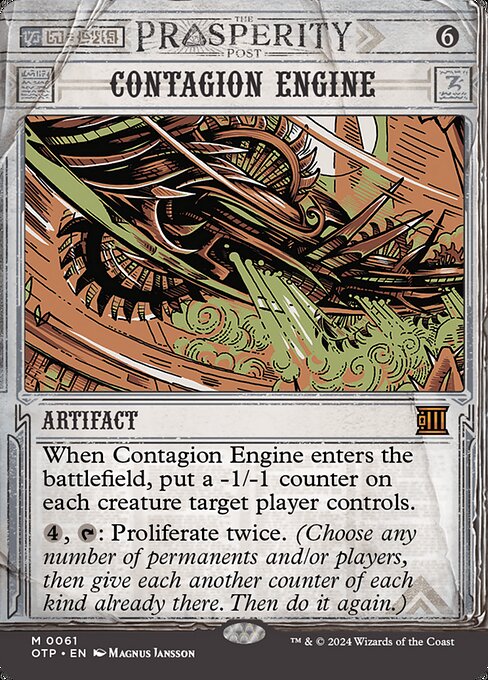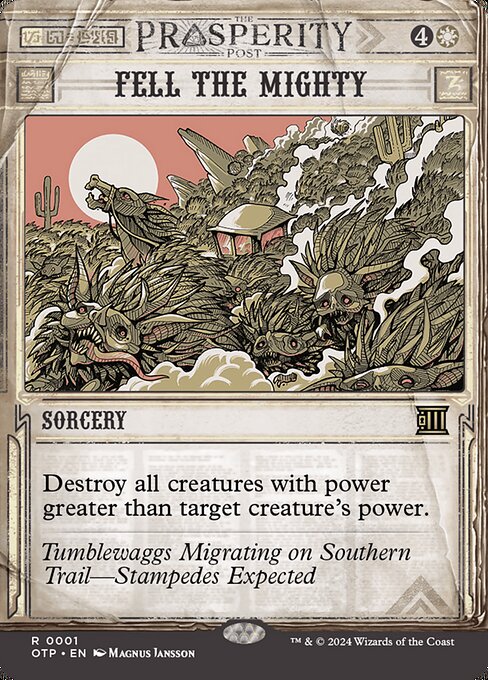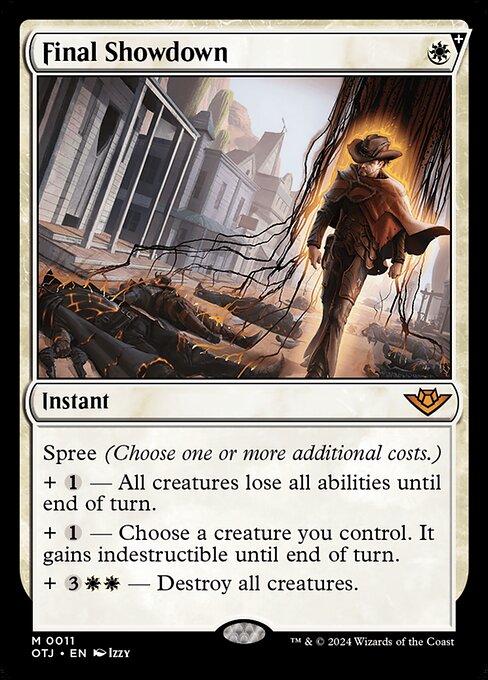Table of Contents
New set is upon us and as I write those words I realise how titanic a task the review of removal is in this set. All thanks to the design teams idea of putting a bonus slot filled with cards that target opponents and their creatures. Still – nothing compared with the toil j2sjosh had to go through to review the whole set.
But traditions need to be kept – so in the next few thousand words I will try to introduce you to the wealth and depth of limited removal in the new set. Because I think it is worth it. Without ever touching Outlaws of Thunder Junction (OTJ) cards, the set looks to me like a contender for an all time great – and I don’t usually hype a set before it gets released.
As always I will first look at the format creature sizing specifics and then focus on five categories of removal:
Vital Statistics
Each set in Magic’s history is different and one thing that varies from one expansion to the other is creature sizing. Creature sizes determine many parameters of the format: its speed, aggression level, but importantly for this article – also how does the removal align with its targets. A simple example: a card like Shock can be great in some formats but mediocre in others and the sizing of the creatures plays an important role in that.
OTJ looks like a particularly interesting set in that aspect. It has unique creature sizing distribution:

At common, as those are the creatures we will see the most, it has tons of extreme results. It has the highest fraction of 2 and 4 toughness creatures from any recent set. Especially in case of the 4 toughness creatures, it is an extreme outlier with a quarter of all creatures at common having 4 toughness. LTR and ONE were previously the sets with highest X/4 fraction and they only had 17% of those.
At the same time 1, 3 and 5+ toughness are underrepresented. OTJ is either lowest of all (X/1s) or close to lowest (X/3s and creatures with toughness greater than 4) values for those. This graph shows the last 8 formats for clarity’s sake, but if you are brave enough to venture into a more complicated graph, OTJ still looks an outlier:

Even going as far back as Kaldheim the fraction of 4 toughness creatures is unprecedented. Number of X/2s is still 2nd highest and X/1s – 2nd lowest. We are venturing into and unknown territory here so it will be interesting to see how will those numbers impact the replayability and fun of the format.
One thing that this causes is a narrow range of toughness. Graph below shows the percent of creatures at common that have between 2 and 4 toughness:

Almost 80% of creatures in the format fall into 2-4 toughness range. This is also unprecedented. Normally this value is closer to 65% – a whole 15%p less. Only Kaldheim had a close enough value for that metric at 74%, with a handful of sets being around 70% mark. It is going to be interesting how will this property of the format impact the games, but my hypothesis is, it will either encourage trading and lead to small boards or encourage board stalls. Those two seem to be quite opposite, but keep in mind that which one is correct will depend on your decisions during the game. If you offer trades – those offers will be likely taken resulting in a small board, if you stay back and the opponent will allow it – you end up in a board stall.
Last interesting property of OTJ is the similarity in sizing at common and uncommon creatures. Typically at uncommon we get a bit more of the larger creatures. This gap is particularly visible in the 2 toughness or less creature slot. This means that if a 2 damage spell kills 50% of creatures at common, it will normally kill 35-40%% of creatures at uncommon. Not in OTJ however, where the gap is almost non-existent, meaning the uncommon creatures are smaller than normally. The graph below shows the gap between common and uncommon creatures with toughness 2 or less in the recent formats:

As you can see, while in almost every recent set the difference between the fraction of lethal targets for a 2 damage spell between commons and uncommon creatures is over 10 percentage points, OTJ has only 2.8%p difference. This means the uncommon creatures will more often be value oriented smaller creatures rather than rate monsters. It remains to be seen what does it mean to the play patterns in the format but it will be interesting to see if that changes how the format plays out.
Conditional Removal – Damage
The sizing of the creatures is the most important feature for the removal that kills creatures through damage (or in case of some black spells – by giving a creature -X/-X). How efficient are different spells that deal damage based on how much damage do they deal? Graph below sums up all the different spells in the format that deal damage:

As I mentioned before, this set is particularly low on one drops. But thanks to a high number of 2 drops spells dealing 2 damage are as good as they are on average, if not better thanks to more targets at uncommon level. Similarly, 3 damage spells are slightly better thanks to the uncommons having more X/3 creatures, but at common 70% is a typical value for a 3 damage spell. 4 damage is killing more creatures at common than we have seen since Kaldheim – but difference here between OTJ and other sets are not very big, although the difference between 95% of killable targets and 85% of killable targets may be larger than you think. Just look at it from a reverse perspective: being dead against 5% of creatures is much better than being dead against 15% of creatures. Spells dealing 5 or 6 damage are as close to being unconditional removal as you get.
So, what damage based removal will he get access to this set?
Red is traditionally the ruler of damage based removal spells. And in this set it has access to plenty of choice. Nothing to deal with X/1 creatures, but fortunately there are not many of those in the set anyway. But in the 2 damage slot we have several cards.
Thunder Salvo deals 2 damage at instant speed but is relatively easy to upgrade to a 3 damage spell if you need to kill a 3 toughness creature. if your mana curve is on the low side that is. And it will naturally fit in the cast two spells a turn decks.
Longhorn Sharpshooter is an interesting take on Plot mechanic. A 3 mana 3/3 reach creature that can turn into a 4 mana kill spell that turns into a 3/3 at a later turn. No reason why this modality would be bad but I think we still need to wait for the early format data to see if this ability is great or merely good.
Legion Extruder is an interesting build-around card from the BIG expansion you will sometimes see in the OTJ packs. Base level – it is a 2 mana sorcery speed Shock, which is not great. But if you have some Treasure generation, other token production engines, upgrading them into a 3/3 Golem for 2 mana is a real gain, that will pay back the initial investment and then some. I would guess this card needs to have at least some synergies to be playable, but if you do – can be excellent.
There is no 3 damage spell in the main set, which is unusual, but when it happens, we get a common red removal spell will deal 4 damage for 3 mana. But OTJ is not a regular set. Aside from the cards from Thunder Junction we are getting a bonus sheet dedicated to crimes. And what better crime than dealing 3 damage to anything (that includes face, don’t forget) for 1 mana?
Skewer the Critics will be most likely seen as often as other uncommons in the set. So keep that in mind – that strange attack might be just an attempt to enable Spectacle. Whether you manage to cast it for 1 or need to pay the whole price, Skewer is a solid card you will be happy to run in any deck, although the UR double-spelling looks like a natural home for it.
Explosive Derailment seems a premium red removal spell in the format. 3 mana to kill ~94% of cards at lower rarities and almost 80% at high rarities is a really good value for a humble 3 drop. And occasionally the mode to kill an artifact can be useful if not game-winning. Especially when you still kill the best available creature at the same time. A strong candidate for the best red common.
Collective Defiance from the OTP bonus sheet is a different take on a modal spell from Spree. This one has Escalate, allowing you to cast extra modes at extra cost. Dealing 4 damage is the obvious choice, but adding extra face damage or some card selection if you are getting flooded might be useful too. Mind that it is harder to cast than Derailment and lacks the flexibility of an instant so probably it is a worse card than the common from the set that needs to be picked higher because of Arena economy.
A card that will make the Sheoldred players’ life just that little bit harder in her last few months in Standard, Scorching Shot is the equivalent of a rate monster in the removal world. RR for 5 damage makes it somewhere between Shock and Lightning Bolt range. Card looks great but be wary: in order to play it, you need to be heavily into red.
Furthermore, we get Snakeskin Veil in green and Take Up the Shield in white, among others, that can be a really painful blowout if you time this removal badly. Try to avoid signalling that you have it in your hand – people do notice if you are tapping manually in a way to keep RR untapped.
On the positive side – 6 damage kills virtually everything. Instant speed is nice to have. Additional killing of the token is also great and will probably matter once in a while. But we are still talking here about a 5 mana spell. Expensive instant spells are a bit easier to anticipate from the opponent, so playing it may mean you lose some of your surprise factor. Looks to me like a filler card, especially with so few larger creatures in the format. But a great option to have in your sideboard.
The X spells are back in this set – as we have a total of 3. All at higher rarities, but still.
Hell to Pay is pretty bad rate – you will only be able to kill an X/4 for 5 mana. But if you are having any Treasure / Artifact synergies in your deck maybe it is worth playing. I wouldn’t be prioritising it though. All the common removal spells mentioned above look better than this. I would preferably not play it over them, which means I probably never will.
Crackle with Power is a removal. Technically. Practically it is just a Dopplegang. Casting it for 5 mana is the emergency mode to survive – and sometimes it will happen. But where it really is is casting it for 8 or 11 and doming the opponent for 10-15 damage ending the game most likely. Great finisher for a slower ramp deck.
Electrodominance is even worse rate than Hell to Pay. But it is an instant, and you get some of the mana you spent back. Hopefully. Remember that you can cast permanent and sorcery spells with the Electrodominance ability so if you manage to cast it during opponent’s attack you can ambush their creature. It will also almost automatically fulfil the “cast 2 spells” requirement that is a theme for the Izzet decks so Electrodominance looks particularly tasty in that archetype.
Last of the red damage removal spells is an eponymous spell for a whole category of effects. You will not play Fling often, or at least you shouldn’t, but some decks just need a finisher and also happen to have large creatures somehow – if that is you, you may consider Flinging them. Face or elsewhere.
But damage removal is not only the domain of red. Black usually has it in the form of -X/-X spells.
The only X/1 slayer in the set but this card can be much more than that. In the world of very narrow ranges of creature toughness, the 2 point swing in power and toughness can easily mean turning this inconspicuous one mana spell into a two-for-one. You have a couple of 2/2 creatures, opponent has the same and one black mana open – do you dare attacking into it? The cheap cost is key here and I predict the card will be as good as Murder in the first weeks of the format before people learn how to play around it.
Desert's Due is the black version of Thunder Salvo It will be probably just OK on face value but once you have 1-2 Deserts in your deck it becomes good to premium. The difference between those two spells is Salvo will be a 3 damage spell more reliably in the early game, while Desert's Due is a much better late game removal as you will likely draw into your Deserts by then. Armed with this knowledge, you should be able to figure out the best homes for each of the cards.
Ambush Gigapede is a very expensive, but potentially a 2-for-1. I predict it having little impact on the format. The exception may be the Intimidation Campaign build-around. Gigapede looks at home in that deck being both a natural 2-for-1, crime committer and fitting within the late game plan for the deck. Still this is a niche use.
White has only one damage based removal. Steer clear is cheap but this type of removal is much better suited for a control deck. While having Mounts in your deck looks like an aggressive game plan – as you need both Mounts and creatures to Saddle them. I am not a believer in this card but if a controlling deck doesn’t mind it as a deal 2 damage for 1 mana or if defensive combat tricks become an issue in the format, it may be playable.
Green damage spells are different than the ones we have seen so far. They usually come as Fight or Bite spells – with one of your creatures either exchanging damage with something (fight) or dealing damage to something (bite) based on its power. This type of removal has flaws – sometimes you will draw a bite spell with nothing on board, sometimes your creature will be killed in response to the spell, so be careful while playing it and set your removal turns well to minimise the blowout.
OTJ’s main set has only bite spells. It seems to me Wizards learned that fight spells really need to pack a punch to be competitive so in recent years we see mainly bite spells represented in the sets. And we have a couple of new ones.
Throw from the Saddle is pretty competitively priced. A bite spell that allows to kill a bigger creature than anything you have is a good rate for 2 mana. And if you do have some Mounts, a permanent bonus looks sweet. A premiere green removal, despite the sorcery speed. Just make sure (and this goes with every spell here) that you do have creatures. And don’t forget that Ankle Biter is good in biting.
Clear Shot is a reprint, and what a card it is. One of the all time greatest removals for Limited in the game’s history. Certainly for green. Looks like a more expensive version of Throw from the Saddle but instant speed changes everything here. Playing it post blocks to win a combat and kill something is a game winning play so don’t sleep on that card.
Betrayal at the Vault is another potential 2-for-1 at a premium price. Being able to kill 2 things is good but with that possibility comes the risk of spending 6 mana for nothing. This card has to be played with all the available carefulness – if you manage to do it, you might get good results in your slower grindy green decks. While playing such high blow-out potential spells, you might want to use protective spells like Snakeskin Veil in conjunction with it.
There is also a green Fight spell in the set. Primal Might allows for great flexibility – it can range from a 1 mana fight spell that you can easily slot into a double-triple spelling turn but it can also be a powerful finisher acting as a sorcery speed +7/+7 pump spell. Remember that the fight is optional – very much like it was with Repulsive Mutation in MKM, you are totally in control of what the spell does.
OTJ is a set with plenty of multicolored cards and there are some powerful damage removal spells among them:
Roxanne, Starfall Savant looks great. 5 mana for a 4/3 body, a mana rock that originally cost 5 mana I remind you (although 5 mana Meteorite was unplayable, I am sure there is a design team inside joke in there somewhere), with a potential to get more mana rocks next turn and double mana from them as long as Roxanne is alive? I am in. Great rate on this one – looks like a good piece for a multicolor legends deck but will work perfectly fine in any shell really.
Slick Sequence requires some work. And doing that work removes some of the benefits Shock offers. But if you are in UR double spelling archetype (as one would hope so drafting this card) – I am sure it can be great. Drawing a card while shocking for just 2 mana looks like a great deal. But remember – cards like Slick Sequence usually do better in the hands of great players because they know exactly when to sacrifice the card draw value and cast the cards as is – as an overpriced Shock. It won’t be often but Magic is a game of fine margins. Figuring that one out will and being able to get the now value over the future card draw make you win more with it.
Another blast from the past. You will rarely double-spell with this one but it will set you up for a future turn with the selection it offers. Hypothesizzle was a great card in its format and no reason to expect it being bad here. The UR archetype looks card-hungry so any draw helps, and draw and removal together looks great.
Ok, High Noon is technically not a multicolor card. But to get the full value from it you need Boros mana. I would never play it main deck. The cost is excessive. But if you are matched up against a deck reliant on casting 2 spells a turn for synergies, and I mean heavily reliant, you might want to side it in and later in the game use it to kill something or go face to end the game.
Annie Joins Up is hard to cast. Annie Joins Up has a niche upside. Don’t play this card willy-nilly. But. It certainly is a sweet build-around if you end up in the right seat. Which will be once in 50-100 drafts, so don’t keep your hopes up but if you are feeling like losing gems to try and have fun – this is a card for you. Just don’t tell me later I didn’t mention that it’s not responsible. Sweet things in Limited never are.
Green gets a package of 3 multicolor fight spells in the bonus sheet. Depending on your flavor of Green deck you can get one of those.
Decisive Denial is a modal spell – you can chose to fight or counter a non-creature spell unless opponent pays 3. This flexibility is useful. I don’t foresee it being a bomb but will definitely be solid.
Savage Smash is the Gruuliest card there ever was. making things bigger and fighting on a card with Smash in the name? Say no more. It was also a great card. With several 4/2 creatures in the format, Smash can lead to some non-games if the Gruul mage is on the play and starts their sequencing from making a 4/2 into 6/4 and killing opposing blocker. Being ahead on life in aggressive decks will force the opponent to make non-optimal choices, limit their possibilities and Savage Smash enables it.
Back for More is the value fight spell. Good in slow decks that aim for a late game and have graveyard synergies. Can potentially be a 3-for-1 and often will be a 2-for-1, just make sure you have some ways to fill your GY with fodder and your deck is tuned to reach the late game and you should be fine. Premier friend of this card should be Spinewoods Armadillo: it puts itself into graveyard, makes sure you get the lands, and cushions your life to enable survival. And then is perfect with Back for More thanks to the Ward.
Conditional Removal – Other
Not all conditional removal focuses on toughness. There will always be a pool of removal spells and effects that look at power, mana value, key words and types. My feeling is we are moving slightly away from conditional removal in set design recently but it still has an important place in the format.
White has the most abundant conditional removal package.
Getaway Glamer looks really good actually. It is great when you are behind – opponent having the largest creature or tied for largest? No problem. Glamer covers it. Even when you are ahead you can blink your large thing to kill their second largest thing. Price is competitive, speed is instant – plenty to like here. And in some cases you will use it only to flicker something which is also not bad at all. At this stage – I am also afraid to ask what Glamer is but I trust the WotC linguists.
Eriette's Lullaby looks like a great spell in a category that notoriously underperforms. Getting 2 life back on this type of spell is a very useful ability, the problem is this type of spell is not great in best decks in modern Limited – proactive aggro decks. Lullaby is a weapon from more elegant times of do-nothing Limited and I doubt there will be a great home for it in OTJ, unless some Esper control shell is viable.
Fierce Retribution is in the same gist as Lullaby. Instead of life gain you get the instant speed which will be as good as if not better than gaining some life in many cases. Given this, Lullaby and Steer Clear and a plethora of sweepers, maybe there might be a control deck in this format after all. But I would approach this idea cautiously.

Shoot the Sheriff is the kind of removal that looks appealing but upon closer inspection seems much worse in Limited. Those types of cards tend to be much better in constructed formats, especially if types they can’t kill are underrepresented (see Go for the Throat in Standard and people sideboarding in Phyrexian Fleshgorgers and Steel Seraphs to counteract this card). Hitting 60% of creatures in the set is OK (see graph above), but you have to take into account that in some matchups you will barely have targets for it. Something to keep in mind. You will still never cut the first copy though, but this is a card easier to overrate than to underrate.
We have seen this creature so many times. A 4 mana creature that kills a damaged creature on ETB. Normally it is bad but here I can actually see it work. 2/2 lifelink flying is just good enough to consider playing it on rate. And once in a while you will nab something – pure upside. I think it is the defining feature of OTJ. Some traditionally bad cards have been printed with a body that is acceptable on rate. Let’s see how that will play out.
Thornado, even with cycling, will likely be a sideboard card. It just doesn’t do enough and colored mana in the cycling cost is a lot. Still keep it in mind when playing BO3 or at the prerelease – great way to get an answer to a bomb you saw in game 1.
Ride Down only kills blockers. This means you want to be attacking in order to play it. Make sure your deck is more likely to be on the offensive than not, as in the latter case, your Ride Down is completely useless, putting you even deeper in trouble. In explosive aggro decks the card is great though. And Boros is traditionally an aggressive color pair.
Vanishing Verse is a very potent removal, but not omnipotent. It deals with 95% of commons but it wont be as good dealing with the rare cars, as 40% of those are multicolored (or no-colored). So you can count on it dealing with chunky common creatures but if you plan on dealing with the most attrocious bombs using this card, you might be in for a disappointment.
Abrupt Decay will hopefully trade up on mana, can’t be blown out and can deal with permanents that are not creatures. All this at instant speed – if you are in BG you are definitely interested in that deal. Especially with roughly 2/3rd creatures being legal targets for the spell.
Tyrant's Scorn is the same but in Dimir. And with some flexibility. Being able to bounce a large creature adds to the repertoire of the card – great thing to have in a spell like this, especially in an archetype that cares about committing crimes.
Unconditional Removal
Sometimes you want to be sure the thing is dead dead, and you don’t want to play the percentage game of the conditional removal. This is where unconditional removal comes in handy. This is why black is considered the king of removal. But unconditionality comes at a price leading to the ironic outcome that in recent sets black struggled as a color because too much of its power was invested into removal while removal was not great. Will OTJ change it? Too early to say – but we can look at unconditional removal spells and see how good/bad are they.
Well, there is definitely one key change. In OTJ it is White that gets more of the unconditional removal spells, not black.
In the main set we get 3 removal spells.
Bovine Intervention turns its target into a 2/2 Ox. The price is competitive, but giving opponent a 2/2 is a harsh drawback. In modern Magic, removal that leaves so much value on board is not going to be playable despite the excellent punnery. PS. My candidate for the next card in this style is “Imprisoned by the Moo”. But make it playable unlike the original.
Mystical Tether is just an Oblivion Ring, but you can pay 5 instead of 3 mana for it to be able to cast it at instant speed. This looks great and looks like a prime white common removal piece.
What if we added something extra to an O-ring? How about a lil mercenary? Every time we had an effect like this in recent history it ended up being one of the top cards in its format and I don’t expect this one being an exception.
The bonus sheet ads even more exile based removal – so much of it in white.
Path to Exile is a card needing little introduction. A constructed staple for many years, now basically not played anywhere. And for a reason. Giving opponent a land is a price. You may stem a bleeding here just to expose yourself to another stab. But in Limited this is still a powerful effect. My advice to you is: treat it as a 6 mana spell, that just happens to cost 1 mana and play it at this stage of the game. Then ramp matters less and targets become juicier.
Journey to Nowhere is a 2 mana O-Ring. Same things apply to it as to other O-rings in the format. Incidental enchantment removal will be so good against white decks.
Leyline Binding is a 3-4 mana O-Ring with Flash. You will definitely pick it in paper but also on Arena it is playable in Limited, but don’t expect the levels of brokenness it can reach in a dedicated constructed deck.
Black is not as rich in unconditional removal as white is, but there is some power there.
Consuming Ashes exiles a creature but with no chance of it coming back, like in case of the O-Rings. Solid removal at instant speed but let me stress it (and it applies to all the black removal spells) BB in the cost is a real requirement. If you have a 9/8 mana split, with B being 9, you will only be able to cast Consuming Ashes on turn 4 in 85% of games. From 8 Swamps the odds of being able to cast it will drop to 78% as per classic Frank Karsten article. But if you are heavy into black – Consuming Ashes should be great especially with that additional flexibility if you have to waste a premier removal on a cheap creature.
Unfortunate Accident, if anything, looks even better than Ashes. For 4 mana it gets the job done and kills something but add one more mana and you get a 1/1 Mercenary. This makes it very flexible plus opens some outlaw synergies black is happy to have. A great card if you are heavily into black.
Lastly on the bonus sheet we have our old friend, Murder. Didn’t deliver last 2 times when it was printed as a common but I have a good feeling about it this time. It seems to me being able to snipe a key piece on opposing side will be essential in this format unlike MKM and SNC where removal was not key for winning games.
The blue unconditional removal is usually limited to tap auras. OTJ is no exception. This time we get a Flash variety for 4 mana. As far as the power goes it looks fine. The creature loses all of its abilities so it won’t accrue any value for being on the battlefield. But 4 mana is still a lot for that effect – in black for 4 mana you get removal that can be Disenchanted. In White you get the same effect for 2 mana, 3 mana or for 4 mana with an extra 1/1 tagged on to it.
Moreover, the O-Ring effects in white can’t be negated by an untap trick, like stop cold can. Generally the blue tap removal did not deliver in most of the recent sets – it is time to either rethink it or scrap it, card slots in sets are too valuable to waste them on trap cards.
Esper colors got the bulk of unconditional multiclor removal, hardly surprising when you think Black, White and Blue are the colors of this type of removal. But the quality of those is also through the roof.
Assimilation Aegis is an Equipment O-Ring. It gets rid of its target until it gets destroyed. But wait, there’s more! It can turn the equipped creature into a copy of the oblivion’ed card. Amazing if you nab something impressive with it, this will end the game in a hurry. A reason to be UW if I have seen one.
Detention Sphere is the 6th O-ring in the set so far – I get it – pacifism is bad. Good that WotC also gets it, still that many O-rings is a bit excessive. Detention Sphere is also worded in such a way that if you bounce it or kill it with the enters the battlefield effect on stack, the leaves battlefield ability will trigger before anything is exiled and not return anything, then the exile effect will happen and the target (and things with the same name) will get exiled forever, allowing you to reuse the Sphere on something else. A cute interaction that might give you a small edge here and there.
Fractured Identity is a powerhouse. Control Magic is a powerful card, but it can get disenchanted, stolen creature can get bounced back to owner’s hand. Fractured Identity has all the upside of Control Magic but no downside. The threat is dealt with forever, bouncing doesn’t give anything back to opponent, Disenchant is useless against it. This is a bomb. Just think how good already something like Coerced to Kill was in MKM, and use your imagination on just how much better this card is. A first pick in 99.9% of the packs.
Ruthless Lawbringer is an interesting card but at the same time, one that is hard to evaluate. The costing and ability look competitive but only if you have the right type of fodder to sacrifice for it. I wouldn’t want to sacrifice a 2-drop to kill something, I would rather get rid of a Mercenary token, preferably after I tapped it to boost power of something. A cursory look at the spoiler tells me there are some cards in BW that can generate tokens, but we are not drowning in those, which means to me you will have to put some work in to make this card great. One option that I take into account given the abundance of fixing, is that Lawbringer is a Mardu card, a stalwart of a slower grindy deck based on generating small creatures and converting them into card advantage in an attrition-style deck. Hard to say if I am right or not but good to at least admit the possibility.
Anguished Unmaking is a Murder that requires you to pay 3 life on top of it. 3 life is a lot. I don’t think that being able to kill one of the six (so far) Oblivion Rings is enough for me to excuse such a sacrifice. Loss of life is a much more acceptable thing in deck that plans to end games quickly, but WB looks to be more grindy attrition than aggro offensive so I am skeptical about how powerful that card is. I think it will have a relatively low win rate and should be drafted as filler. Why is it a Mythic anyway?
Oblivion Ring no. 7. And the last one, I promise. A recent design, well tested and proven to be powerful. If you are in WG or 5C G you will be thrilled to play it. Great card to have in your deck and you will never want to cut it.
Terminal Agony is overpriced on the face value. But if you can engineer to cast it for the Madness cost, can be great. Casting Discerning Peddler or Highway Robbery and discarding Agony will feel like winning a game, but that good feeling shouldn’t make you forget all the other times when it will be nothing more than a 4 mana removal spell.
From an overpriced Murder to a very very hard to cast Murder with a slight upside. If you are in RB you are ok to play it but as with Agony – no reason to be ecstatic about it. Until you kill Oko, Thief of Crowns with it, of course. Tag me then when you post the screenshot online so I can celebrate your good fortune.
The traditional clunky colorless catch-all removal. Probably will be unplayable. I will still try to do something with it and Ertha Jo, Frontier Mentor, because this is the kind of a person I am. If you want to keep your gem count intact, don’t be like me though 😉
Three color cards are hard to cast. 3 MV 3 color cards are extremely hard to cast on curve. This means I want something special from a 3 color card to put in my deck. Not a slightly better version of an existing effect. Both Endless Detour and Void Rend are both exactly that. A harder to cast removal spells that need 3 colors to be cast. This is fine if you – for some reason – already are in those specific colors. And I want to stress – fine. Not amazing, not great – fine. Definitely not a good reason to go out of your way to include any of those in your deck. But if opportunity arises without much extra cost – why not?
Tempo Removal
Among countless definitions of “tempo” in Magic, my favourite is “converting resources to time”. And that is what I selected to represent in the tempo removal slot: cards that make you waste cardboard and mana to gain time in games. Tempo removal can be used defensively: by slowing down attacks from your opponent for long enough, that you manage to stabilise the board and start turning the tide in your favour. But you can also use it aggressively – removing blockers or making sure you are the winner of a racing situation. Tempo removal traditionally centres around blue, occasionally venturing into white. And this is no exception here. Spells will mainly either bounce a creature back to owners hand or put it on top of opponent’s library.
Failed Fording is a typical bounce common spell – 2 mana, with a potential upside, instant speed. This time you get to surveil 1 if you have a Desert, but you can also return any permanent. This might come in to be handy with some of the older Oblivion Ring cards in the set, was you can bounce them in response to their ETB trigger. This will make the target disappear and never reappear as the “return to battlefield” trigger will activate before the creature will be exiled – this works out in a similar way to The Princess Takes Flight card from WOE allowing you to reuse the O-Ring on another target. Still, most common use will be just to bounce something and gain precious time. Another use is blowing out one of the many fight/bite spells in the format so if you are on the biting side – make sure you don’t play your removal into open blue mana.
Peerless Ropemaster is a very big Man’o-War, but can only bounce tapped creatures. This looks like a dealbreaker to me, but I reserve an option to adjust my opinion as we see how the format plays out. 4/4 stats is legit in blue, so maybe it will be a fringe playable in the end.
This Town Ain't Big Enough is a cute modal spell. You can either bounce two permanents from your opponent or one of yours and one of theirs. Again – this works with old O-rings and 2 mana to reuse an O-ring and bounce something is a really good deal. 5 mana to bounce 2 permanents is also a reasonable price, so I expect this to be a solid to premium uncommon in your tempo oriented and even control blue decks.
But if you are looking for tempo power – bonus sheet is where it is at. Possibly the best tempo spell of all time is there in Repulse. If you doubt its power, trust me on that one – this is a first-pickable card. Instant speed bounce that gives you a card means you basically only invest mana into gaining time, which is much better than investing both mana and cardboard. Repulse is set to be one of the best uncommons in Blue, if not the best and should be prioritised accordingly. The power creep made older creatures look like buffoons compared to modern designs, but the same can’t be said of spells. Among many bounce spells printed in recent years none come even close to the power level of Repulse and just remember how good Tolarian Geyser was at sorcery speed in DMU. Now try imagine the same spell but capable of blowing out a combat trick, aura, triggered effect.
Jailbreak Scheme is sorcery speed, but at a competitive price. And with a potential little bonus – the second option is not something you would put in your deck, but on rare occasions this effect can be game-winning. Nice to have access to it while using the Time Ebb ability 95% of the time. Power of this effect is normally very reliant on power of blue altogether, ranging from amazing in sets with good blue to unplayable if blue is weaker – so a lot of how good this card is relies on other blue cards in the format.
One white tempo play, but one that you should be aware of. Bouncing a spell and forcing the opponent to recast it on the next turn will work with creatures spells very well. It will be even better in some types of non-creature spells – counterspells become useless when plotted, combat tricks become much weaker. And the upside is a 2/2 flying creature that will make plotting useless in general for your opponent. High pick and a powerful card.
Sweepers
Sweepers are the most dreaded category of removal. Like no other cards they neutralize the game, cancelling what was done prior to the sweeper. And OTJ has a wide selection of them, from small sweepers aimed at aggro creatures to unconditional wraths with upside – OTJ has it all.
Neutralize the Guards is technically a mini-sweeper, killing all of the (arguably few) X/1 creatures. But the real power of this card is in combat. It is an Instant, so you can play it in the middle of your attack as a sort of weird version of On the Job – completely turning combat math on its head. 3 mana is a bit, and Skullduggery does a similar thing for 1 mana, but still card can find uses in some aggressive Black builds and surveil 2 is a neat bonus, close to drawing a card in later game.
Caught in the Crossfire is a modal mini-sweeper. Depending on the board state you can sculpt it to favor you. How well you will be able to do it will be very much dependant on both your deck and opponents one. For maximising the potential you want to have a good mix of Outlaws and non-Outlaw creatures, so you can plan your plays to impact the board but keep the category you want to target out of harms way. Still, RR in the cost and 3 mana is expensive enough I don’t expect it to be among top uncommon and relegated to filler in decks that can make a good use of it.
Harvester of Misery is far from filler. -2/-2 minisweeper coming on a 5/4 creature is powerful. But this one also gives you options – to kill something smaller for only 2 mana. Great if you plan to recur Harvester later in the game. You will pick it high and be happy about it.
Pest Control looks like a constructed card. I doubt you will want to play it main deck, even with the cycling cop-out. There are just not enough 1 mana creatures and I doubt many deck will have enough tokens to make the investment worthwhile. Still, keep it in mind as a sideboard card if you ever pick it. But since I don’t think you should prioritise it, that will rarely happen.
Some sweepers are not by definition for small creatures but require some extra hoops or conditions to be fulfilled.
Crime // Punishment will sweep only things of a certain mana value. This is more of a conditional removal where you can sculpt a 2 or even a 3-for-1 if you play it well, albeit at a substantial mana cost. It comes with the upside of modality – you can sometimes reanimate something great from opponent’s graveyard if that is more convenient for you. I don’t think the card will be great but in a Golgari deck with good mana fixing and ramping might be just good enough to play it.
Rush of Dread won’t wipe the board but it will remove a good chunk of it. If opponent has 3 creatures, you will nab 2 of them, but the largest threat will remain alive, which is not that great. Still, other modes might just push it over, you should be playing a deck that plans to have a long game to include it though.
Contagion Engine is a Plague Wind in instalments. Expensive, but powerful and eventually will get you there. As with previous cards, it wants to be in a deck that is comfortable to get to a late game – preferably by stalling the board. If you are drafting this type of deck, then you are in the market for this type of sweeper.
Fell the Mighty can range from great to pretty bad. And it is this floor of it as a 5 mana do-nothing that worries me. In order for it to be good, you need to play decks that want late game, play defensively statted, small power cards and I find it hard to envision a deck like that. If not, you will find yourself in situations where multiple creatures opponent controls will live through it. One cute interaction is to double-spell Fell the Mighty with Take the Fall making your larger creature the only survivor, but I don’t think this is a dream worth chasing.
Last, but not least, we get the sweeper royalty. Unconditional Wraths that truly reset the game. Or – in case of those two – likely end it.
Final Showdown is a modal spell. For 6 mana it is an instant speed Wrath. For 7 mana – your best thing will live through it. And there are still some fringe used of the smaller modes – you may kill some flying creatures by having them lose flying in combat or save your great creature. I like fringe upsides on cards that have potential to win the game if you survive to later turns. Final Showdown has all the hallmarks of becoming a limited bomb-level sweeper.
Overwhelming Forces is a card that will probably win 90% of games it is cast in. The difficult part is being able to cast it. 8 mana is a lot but if your deck is built to get there – you an build your game plan around it. Make sure it resolves and it is smooth sailing from that point.
Conclusion
And that’s it! We got there in the end. This set looks like a great one and I can’t wait to get my paws on the cards and start drafting. If you are looking for more prep before the set hits Arena – why not watching my set review. I met with some carefully selected limited players to chat about how we envision the format and how we would build our decks based on what we saw in the spoiler. Some hot takes were had and some spicy techs are shared.
Premium >
Enjoy our content? Wish to support our work? Join our Premium community, get access to exclusive content, remove all advertisements, and more!
- No ads: Browse the entire website ad-free, both display and video.
- Exclusive Content: Instant access to all exclusive articles only for Premium members, at your fingertips.
- Support: All your contributions get directly reinvested into the website to increase your viewing experience!
- Discord: Join our Discord server, claim your Premium role and gain access to exclusive channels where you can learn in real time!
- Special offer: For a limited time, use coupon code L95WR9JOWV to get 50% off the Annual plan!


























